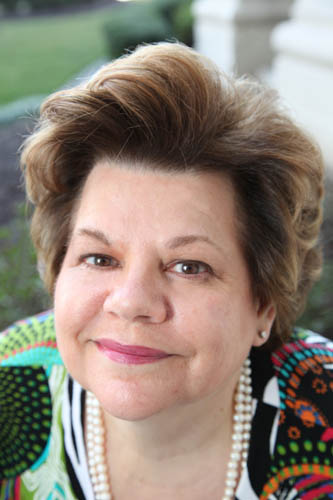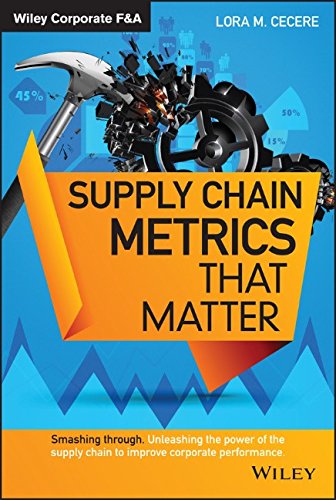Lora Cecere on Supply Chain Metrics that Matter
Interview with Lora Cecere, Founder and CEO of Supply Chain Insights and Author of Supply Chain Metrics that Matter.

Lora Cecere is the founder and CEO of the research firm Supply Chain Insights. She is the author of the enterprise software blog Supply Chain Shaman, which attracts 5,000 readers weekly. She also writes a blog for Forbes and is a LinkedIn Influencer. Currently, Lora’s research focuses on supply chain sensing and revenue management. Her supply chain experience includes specialist roles at AMR Research, Clorox, Gartner Group, Kraft, and Procter & Gamble.
Hi Lora! Thanks for your time today. What inspired you to write your book?
I was an analyst at AMR Research and subsequently Gartner. I felt like I had a really rich set of experiences working with around 300 customers. I believe in the promise of supply chain and it was also the 30th anniversary of Supply Chain Management and I wanted to write a book about how supply chain improved balance sheets.
So, I sat down at my kitchen table in the winter of 2011. I started writing what became Bricks Matter, the first book I wrote. I realized I couldn’t write the celebratory book. I couldn’t write how supply chain had improved balance sheets. So after I finished Bricks Matter I returned to this topic. Metrics that Matter became a three-year research project. I hired a research assistant to look at balance sheets and looked at performance and really tried to figure out which metrics mattered. We interviewed supply chain leaders and in the middle of that I decided that I would write this book, Supply Chain Metrics that Matter. I realized that many organizations are very confused about metrics. They are also uncertain about what drives the greatest value from supply chains.

So, I started this book as a summary of this research. Sort of like my PHD thesis. When I sent out early chapters for people to read and give me feedback, one of the people that I worked with for years at AMR Research told me that it was a very boring read! So I thought well, I need to make it more of a story. People like stories. “Joe”, the lead character in the book, is based on an actual client of mine called Joe. And the opening chapter in the book is an actual case study about a team meeting I attended where they would have the inventory “target of the month”. I watched that organization for many years and while not all the stories in the book are about that same organization I find the same trends across many companies:
- Defining metrics in isolation
- Not looking at how they work together
- Not understanding that supply chain is a complex system
- Not being able to align the organization around them
And I decided to write this up as a story. So I rewrote the book, chapters 1-4 to tell a story and I think it is a better book. So that’s a little bit of the history.
What can we learn from corporate performance over the last decade?
We can learn three things:
- The global multinationals and the issues that they have faced in the last decade have been transformational – to a degree that most organizations have lost context. They know things have become more complex but, they don’t really understand how that translates into metrics.
- As we have gotten more into long-term supply chains, we have a longer tail where there is greater demand volatility. That creates more tension in the functions so the functions have become much more siloed, and unable to work with each other. Organizational alignment is really paramount to success so I spent a lot of time focusing on the importance of change management.
- I think most supply chain professionals don’t understand financial balance sheets and most finance people don’t speak the language of supply chain so in my own way, I was trying to make that easier for both groups.
So those are three things I would like to get people out of the book.
Your research found that 9 out of 10 companies are stuck. What advice do you have for them?
They are stuck because they’re not able to manage the holistic system. They are stuck because they are often measuring individual metrics vs. the whole and what they need to do is to look at their supply chain and push it forward.
The story in the book is the actual process I would like for them to go through. How do we determine what’s important? How to align on that? How do we measure on a corporate level, the metrics that matter? And how do we align the organization to focus on the reliability of functions, and at the top level, align with the business strategy? So I told a story but I am hoping that people will use that story to say “Well, that’s not a bad methodology”.
You mention that Advanced Analytics and Modeling are helpful when trying to determine targets in each metrics area and see tradeoffs. Can you expand on that? Why are these types of tools important?
The reason is that you can’t model a complex system in a spreadsheet. There are just too many intricacies so it requires more advanced analytics and optimization. Most people don’t realize that. Especially finance guys who think you can do anything in a spreadsheet. But there are certain dependencies that you can’t really model and are non-linear relationships.
I made the mistake of trying to use predictive analytics with the metrics to find market cap and I found out you just can’t model it in a linear regression. I am hoping that companies think more seriously about hiring people who are naturally curious and try tools that will help them understand the metrics tradeoffs and embed those analytics in their everyday life.
What companies are currently using these types of Advanced Analytics and Modeling tools?
They are typically in the high-tech industry. Semiconductor companies are quite good and diligent about using these types of tools. High-tech and electronics companies, particularly consumer electronics. And then we fall off pretty quickly. Sometimes you can find places where the tools are used pretty well like Frito Lay does demand planning, Pepsi has done some great network design work, but most of the time we find that people are not using the tools very well.
What was most surprising to you when you did the supply chain leader interviews for your book? Did one particularly stand out? What did they have in common?
Most people want you to publish positive case studies but the greatest learnings come from the negative ones so that is always a challenge. Marty Kisliuk’s (Director of Global Operations, FMC Agricultural Solutions) interview in chapter 1 caused me to rewrite chapter 1 three times. I really liked that interview. I thought the contrast between Peter Gibbons (EVP of Operations, Mattel) and Philippe Lambotte (SVP, Mattel) was also very interesting. At the time of the interview, Peter had recently joined Mattel from Starbucks and Philippe was getting ready to join the team after working at Merck and Kraft Foods. I thought it was interesting to see how two senior leaders at an organization can have different perspectives but work together to guide a company forward.
You say that the process to metrics maturity is a journey. How long does it typically take?
Yes, it is definitely a journey. The pace at which Joe digests the information is pretty fast. But two years is pretty typical.
Are there any companies out there that you feel have done this successfully? Gone through the journey?
I think Cisco Systems is a good example of someone who has gone through that journey. I think they have done things quite well. I think Intel has also done things quite well. The 15 Supply Chains to Admire is a good list to look at. It’s interesting to me that in some industries I couldn’t find any companies that made that kind of progress – pharmaceutical, medical device, retail, and hospitals. I think those particular industries have not matured at the same level and I find that there is a widening between those that get it and those that don’t in the industry. I find that interesting.
What’s the most interesting feedback you have received about the book?
I think people like Joe, I think people relate to Joe and that helps the average reader. Most supply chain books are pretty boring so they appreciate the story format.
What is the one key concept you want readers to take away from your book?
Supply Chain is a complex system that has to be managed holistically, end-to-end.
What would you say to the Joes of the corporate world who want to get better at metrics?
I would say look at the metrics that matter in the book – operating margins, inventory turns, and return on invested capital. Sit back and look at trends, then engage across functional teams to see how they can drive improvement. For example, I was interviewing L’Oreal today. L’Oreal talked about how they implemented Cost-to-Serve. Well, less than 1% of companies that I speak with have successfully implemented Cost-to-Serve. However, the key reason that they were able to be successful is that they built a bridge with the operations and commercial teams for an end-to-end cross-functional focus. That would be my feedback to Joe.
So Lora, what’s next for you and the book? Are you planning a book tour?
Yes, we are doing a book tour in Europe. March 16 and 17 in England, 18th in Brussels, and might do the 19th in Milan and then I am working with CSCMP (Council of Supply Chain Management Professionals) to do some small roundtables in the United States and we will take it from there.





